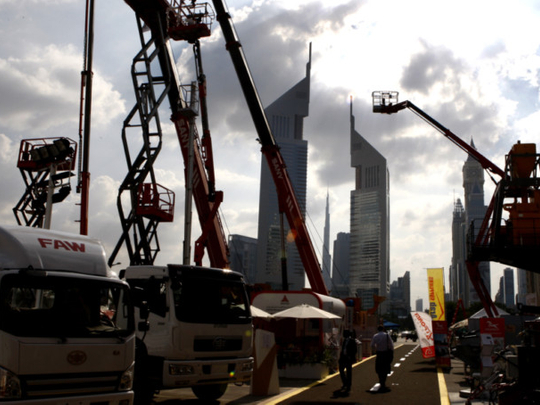
Sustainable building practices and smart technologies are among the topics that dominate discussions in the construction industry. The growing focus on these areas has been reaffirmed by the implementation of green building codes by different countries in the region and the emergence of the smart city concept as an integral component in the drive for urbanisation in the region.
Sustainability and smart technologies were major themes at the recent The Big 5 exhibition in Dubai, the largest building and construction exhibition in the Middle East. The Big 5 is an important platform for key industry players to interact and discuss new trends, solutions and prospects in the Middle East market.
“The Big 5 offered attendees and vendors alike a great opportunity to exchange ideas and the latest information about building development products and services,” says Thomas Bohlen, Chief Technical Officer, Middle East Centre for Sustainable Development (MECSD), an organisation that aims to promote sustainable development through policy certification and research. “This is always a good way to stay connected.”
Some of the participants at the event talked to Property Weekly about their efforts to promote sustainability and smart technologies.
Upholding sustainability
There was no doubt that sustainability was a major theme this year, given the high-profile presentations and segments that focused on sustainability issues. There was the Green Building Code presentation by Dubai Municipality, the Gaia Awards for exceptional yet sustainable innovations in the industry and the two-day Sustainable Design and Construction Conference, which drew high-profile dignitaries.
While sustainable development has been the trend for many years, Bohlen says the concept has greatly evolved from individual projects to encompass more ambitious, large-scale developments such as sustainable cities or smart cities.
Even the theme of Dubai’s bid to host the World Expo 2020 — “Connecting Minds, Creating the Future” — points towards the concept of smart cities, says Bohlen.
“Sustainable development for the future is all about connectivity,” he says. “This connectivity is fast becoming the link between humans, machines and the biosphere.”
Technologies and methodologies in building systems will continue to improve, adds Bohlen. “MECSD has made great effort to become Building Information Modelling [BIM] proficient in order to best serve our building teams in the green building process.”
BIM manages graphics and data, enabling the design, construction and operations teams to make better-informed decisions over the building’s entire life cycle.
“It is worth noting that although sustainable architecture and construction is important within the larger global context, it takes on a bigger role in the Middle East, as the region suffers from a harsh climate and has limited resources compared to its consumption,” says Engi Jaber, Sustainability Coordinator and Architect at Dewan Architects and Engineers.
Solutions from the West
And things can go from bad to worse when the Middle East buys technologies and solutions designed for Western countries and applies them here, as most do not meet the unique requirements of the region, says Abdulmajid Karanouh, Director — Head of Façade at Ramboll, a consulting engineering group.
“This is causing problems on many levels: low performance, both in terms of comfort and efficiency; poor economy, as both capital and running costs are high; loss of identity and ability for local clients and practices to understand the origin of such technologies and how to improve them; and, most importantly, apathy towards research and development at home,” says Karanouh, one of the speakers at the two-day conference on sustainable design and construction.
“The development of contextual and culturally specific solutions is a genuine step towards a more sustainable building design, engineering and construction industry.”
Sustainability needs to be integrated as a process and approached holistically, adds Jaber, who delivered a presentation at The Big 5 on balancing local iconic architecture with sustainable design. “The ultimate goal is to provide a facility that adds positive value to everyone and everything, including the environment, and assuring investors that their investments have contributed to the society and will last a lifetime,” she says.
Bohlen says the region, especially Abu Dhabi and Dubai, has made great strides in improving construction practices over the past few years. The green building movement that started in early 2008 in Dubai and a little later in Abu Dhabi has raised the level of consciousness about sustainable building methods.
However, poor waste management continues to be one of the biggest problems in the construction sector.
“Construction waste can usually be recycled through proper waste management programmes, which can minimise the waste that ends up in the landfill by 20-75 per cent. Several of the projects we have LEED-certified in Dubai have even achieved above 90 per cent, including Easy Hotel in Jebel Ali Free Zone, which had a 96 per cent reduction,” says Bohlen.
Other building practices that affect the environment adversely include using materials and chemicals that are high in volatile organic compounds for finishing works, grading of construction sites without watering down to prevent airborne dust from getting into the atmosphere, using flammable building cladding and failing to properly orientate new buildings, resulting in more solar gain.
Green only in name?
“We find so many buildings that look almost exactly the same in terms of design and use almost exactly the same systems, materials and technology as those in the recent past, yet they are achieving sustainability certificates,” says Karanouh.
“We are seeing minor improvements here and there in terms of contextual consideration, such as orientation and weather conditions. This is coupled with recycling of materials and resources and the implementation of low-efficiency renewables such as photovoltaics, wind turbines etc. While all this effort is highly appreciated, it is not yet sufficient to elevate building design, engineering and construction to a genuinely sustainable industry.
“The challenges everyone is facing in terms of developing sustainable solutions require a higher strategic planning and a deeper and more fundamental understanding of key influencing contextual factors of the design-to-delivery process, including geopolitical, political, economic, cultural, the market and business model and so on,” he says.
Revenue, competition
A glass industry insider working with an international glass manufacturer and distributor who wishes to remain anonymous shares Karanouh’s view on the lack of concrete efforts to promote green practices. He says talking green is all the rage in the region, but all too often a higher premium is placed on a sustainable bank account than on sustainability in the built environment, while short-term gains outweigh long-term environmental issues.
Competition is probably at the top of the list of worries of most businesses in the construction and related industries, now more than ever.
“The HVAC [heating, ventilation and air conditioning] industry is in the process of consolidation,” says Navin Valrani, CEO — Engineering Services Group at Oasis Investment Company, part of Al Shirawi Group of Companies. “As the market picks up, only those companies with access to working capital and sustainable business models are succeeding. This is quite different from a decade ago when market liquidity was high and there was room for everyone.”
Maintenance
The lack of regular maintenance will result in reduced life expectancy of any concrete structure, Hamid Rahim Khan, Marketing Manager — Gulf States at Fosroc, tells Property Weekly. Moreover, a reduced lifespan due to poor upkeep points to inefficient use of raw materials and, therefore, directly impacts sustainability. In this regard, regular asset maintenance is vital for all concrete structures, especially in this region, adds Khan.
“The environment in the Middle East is very aggressive in terms of corrosive agents present in the atmosphere such as chloride, carbon dioxide and sulphates. Proper periodic maintenance must be practiced to increase the life expectancy of structures.”











